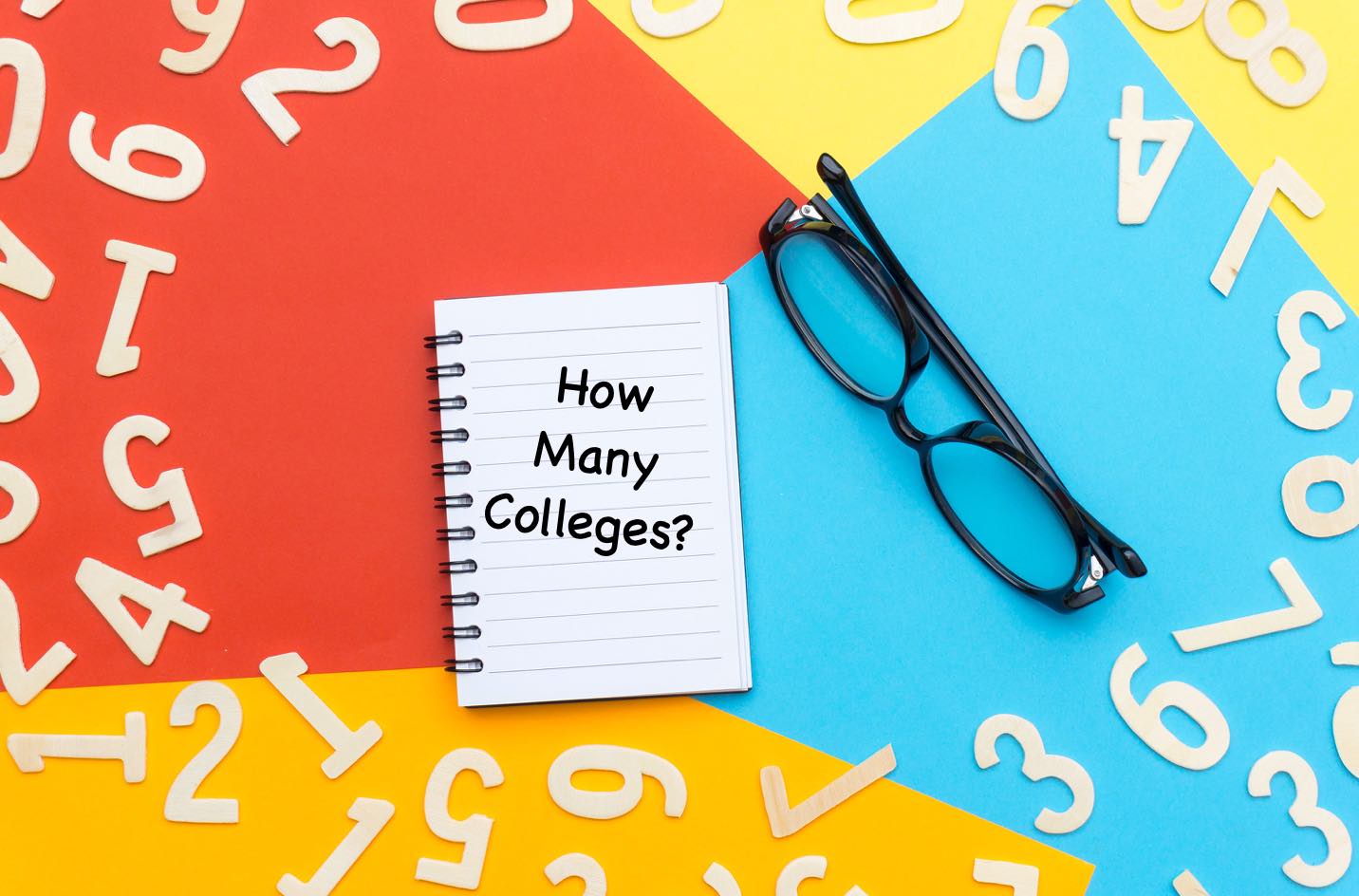
“How many colleges should I apply to?”
How many college applications are enough? Too many? The opening weeks of school in the fall is the time of year when I get these questions from nearly everyone in my senior class.
Most college-counselor types will tell you to apply to 6 to 10, a range that’s usually spread over something like, say, three Reaches schools (dreaming big!), three to four Target or Match schools (the perfect fit!) and Three Safety schools (just in case!).
In the cases of most rising high school seniors, I take issue with that cookie-cutter range as I think that in this day and age, it’s an obsolete one, particularly since the Common App came into being (a topic for another day).
I’ve seen every number of college applications be filed by my seniors in recent years — from only one (against my advice) to a mind-blowing-record 43 (also against my advice, but oh boy, did I admire her ambition and spunk!).
Ten Curious Things Parents Do To Mess Up Their Kid’s College Journey:
College Applications & Financial Aid

Curious Thing #9
Adherence To Old Ideas About the Number of Colleges To Which A Teenager Should Apply
And a Curious Lack of Concern and Curiosity About How Financial Aid Actually Works
The truth is that there is no set number of colleges to apply to.
I’m fond of saying that every college applicant is traveling down his/her/their own self-created rabbit hole, so to speak. In other words, no two students are exactly alike. Some may do best via submitting only a few college applications. But most seniors, at least those who want to experience a more interesting college game board than just the same old crowded state Us and local community colleges, should play hard by building a much bigger final list. I’ll bet this idea didn’t catch fire when you, Parent, were heading into this process as a 17-year-old applicant some years ago. It’s now a different time and place.
insidewink’s monthly column about the college-planning process you and your teenager may be living through or planning to tackle in the foreseeable future.
You can read Part 1 of “Ten Curious Things Parents Do To Mess Up Their Kid’s College Journey” here.
Why Apply to Many Colleges?
3 Reasons . . .

1. The College Admissions Game
So many parents (and their kids by default) tend to be attracted to famous institutions that are CRAZY-selective, usually because of some tiresome notion of what’s “best.”
That gold star of an acceptance letter from one of these hallowed places is nearly impossible to resist chasing through parental persuasion tactics leveled at one’s own children. It’s so easy to look beyond that child’s small weaknesses and believe the much-adored young charge’s best points will shine through the sea of applicants against all odds and WIN. I know. I did it when it was my first-born’s time at “college” bat. There’s a specific unnamed mental illness that smacks so many of us in the face, takes root and then we just can’t help ourselves. But hear me, please.
The certainty of being remarkably disappointed in the final playing out of this scenario is nearly promised.
I’m excited to read Jeffrey Selingo’s new book Who Gets In and Why: A Year Inside College Admissions. It lands this month. I’ve placed my Amazon pre-order and I recommend you do the same. Jeffrey knows his stuff and doesn’t know me at all (in other words, I have nothing to gain here). But from the pre-released passages I’ve read, it promises to spill many closely guarded practices of the college admissions game including an examination of their “crafting a class” efforts. It should help you reconsider this dinosaur of a notion that you/your child/your child’s school has any shred of control or influence over this game that’s played within highly selective colleges’ admissions offices. I said to one of my current moms just this morning that it’s like thinking your kid is playing a game of chess, but little do you know it’s actually a game of Three-card Monte (Google it!).
In a nutshell, I tend to tell my seniors something along the lines of “It’s not really about you, so love your ‘easy’ schools as much if not more than your dream colleges. Since it is indeed a big business that one has no control over, it’s really two games one should play at once — one that’s ‘Boots on Terra Firma’ and a second one that’s seated in a ruthless business-minded realm. The minute one gets emotionally involved in the latter, a weakened position takes form.”
Seniors who aren’t carefully prepped in this manner way up front in September often get their hearts not merely crushed, but full-on vaporized by April. It’s a tough life lesson for any normal kid to learn, perhaps too tough.
RELATED: College Admissions Will Never Be The Same, So it’s Time to Change Your Strategy.

2. College Costs & the Financial Aid Game
“Getting in” is just half the battle, merely the start of so much more fun. For many of you, the actual cost is something you are not yet seriously examining and “Cost” is an incredibly complicated subject.
Remember trying to decipher your first car lease? It sort of feels like that same helpless experience. Instead of trying to understand, some of you still believe the only game to play is the public university option, that is, in terms of getting the best deal — and more often than not, it’s just not the case.
It is normal for me to see students in each senior class receive adjusted yearly cost-of-attendance breakdowns (“cost of attendance” includes room, board, tuition, other smaller direct costs) with bottom-line totals that can be close to or a far cry from a college’s published breakdowns. Here are some examples of some random colleges that to which a fictional kid applied with numbers I made up, based on my real turns in reviewing different sorts of my own students’ financial aid offers (remember, these totals represent adjusted cost breakdowns after applying financial aid and they are not sticker prices — I’ll explain more in a minute):
- UC Berkeley – $37,000 (yes, it’s a public U and its in-state price/cost of attendance is stupid-high for us unlucky Californians!) – more or less the current sticker price.
- Goucher College in Baltimore – $7,500 (private liberal arts college) – far, far lower than sticker price.
- New York University – $70,300 (high-end private university) – pretty close to sticker price.
- Emerson College in Boston – $40,500 (high-end private college) – A viable discount from a high sticker price, but still not easy.
- Beloit College in Wisconsin – $5,800 (private liberal arts college) – significantly lower than the published sticker price.
- American University in Washington, DC – $46,000 (higher-end private U) – and progressively more “higher-end” every year, so it appears.
- University of Redlands – $10,400 (private small college) – a friendly down-to-earth/“everyman” regional choice located on the way from LA to Palm Springs that tries hard to help get kids to college.
These institutions (minus UC Berkeley) are private ones and they publish sticker prices that fall anywhere between, say, $60K and $80K per year. But what’s real is the bottom-line number one finds in the financial aid package that arrives with or after the admission offer.
The all-important financial aid component truly is where the rubber meets the road for most families —
and not the preceding acceptance vs. denial phase on which everyone fixates, similar to being riveted by an exciting championship ballgame.
These made-up-but-based-on-real-life dollar figures in the above examples each represent the “Gap,” which is what the “parental unit” is expected to pay once scholarships/merit aid, grants/need-based aid, student loans, and work-study are subtracted from the “total cost of attendance”, which is the so-called sticker price. If you’ve never encountered this financial aid game, it’s probably worth your time to re-read the previous sentence and understand it. It’s a key concept.
Any given college can end up costing just about anything…
…depending on who you are, how much money you as the aforementioned parental unit makes in a given year’s time, what your child-applicant’s grades and talents look like, what specific schools you choose — hopefully as a family unit with much discussion and gathered information (some schools can be generous one year and not so much the next). There are financial aid tools you can and should learn about as you go that will help you make some educated guesses prior to applying. As you can see, this topic gets detailed and nuanced in a hurry.
There is plenty of great financial aid advice to be found on the internet.
I’m a fan of Lynn O’Shaughnessy’s “The College Solution” blog. Lynn O’Shaughnessy knows what’s up. You should check her out. I’ve taken her online financial aid course a couple of times now. Like Selingo, she doesn’t know me, but I follow her like a disciple.
The federal government requires higher-ed institutions to run Net Price Calculators on their websites. It’s a pretty swell starting place in the case of vetting the financial aid parameters of any given school. However, I’ve found that the delivered estimates based on the figures one inputs are often inaccurate thus there can be pleasant or terrifying surprises to receive. But the sheer exposure to it will introduce you into the feel of things and you’ll start to become conversant.
RELATED: Curious Thing #1: Trusting Your Teen to Totally Handle College.

3. College Applications Acceptances and Denials
The bad news is that any sort of admission denial can and probably will come your child’s way from some or all pursued colleges, particularly if the number of college applications is low or sent to too-selective schools.
The denial can come in a number of painful forms thus playing the numbers in a calculated manner can minimize the certain sting to come. Your young applicant can be knocked out of the game at a favorite school via a swift and cold admissions denial right off the bat in the fall’s early round, which starts in November, carries through until mid-December before the dreaded denial news lands, and sometimes into the first several weeks of the new year.
Or your charge can receive a deferral to the regular round in January/February, keep hoping against hope via subtly courting the fave school’s admissions rep, and then still be denied admission in the spring. Or even worse, your teen can be woefully and forever waitlisted by the dream school after an already long-awaited decision yields neither a yes or no — which usually ends up being a “no” by virtue of an admissions office’s chipper communication drifting away into the sunset via an eventual deafening silence over the long summer weeks following high school graduation.
Then again, your enthusiastic applicant can be accepted to a few, most or all of her prospective colleges, but be shut out of the favorite one because of — you guessed it — an adjusted-yet-still-too-exorbitant cost breakdown that follows the admission offer.
But on the flip side, an offer of admission is a lovely thing to behold. Whenever it occurs, all is right with the world for a cherished moment…even from a so-called safety school.
Aren’t you lucky?
Isn’t your kid fortunate that someone out there intuited and understood his inherent wonderfulness?
It’s a good thing you looked past the shopworn advice to pick a stiff 10 schools and you as a family unit chose a target number of applications that is right for just your child after a lot of consideration. And now you get to face and mitigate the “how to pay for it” game, armed with newly acquired knowledge and confidence.
Missed Parts One through Eight of Anne’s College series? Find them Here.

Anne Cochran
Anne Cochran is an award-winning leader of a small and passionate team of educators who opened Valley International Preparatory High School (VIPHS) in August 2018. — a new charter high school dedicated to providing 21st-Century-informed college options to grades 9-12. As a former marketing veteran within Hollywood’s film industry and small-business owner, Anne redirected her career interests nearly 12 years ago to addressing a need she observed within secondary public education, which is to bring optional college options to public school-educated teens who would otherwise be presented with very limited choices. Anne has been married for over 45 years to Chuck Cochran, creator and namesake of “Chuck Cochran’s Music Lab” at VIPHS, and they have two grown children.
RECENT FAVES
Tips for Hitting the Road with Your Furry Friends
Part 1 of Kathlene McGovern’s 2 part series on the best and safest ways to travel with your furry friends!
I’m Just Curious
Dove Rose give us ideas on how to stay curious! Keep it Fresh in the Kitchen, on the Drive and in your Life. New ideas to keep our mind alive!
Living Unhoused for a Week: Ken Craft Takes to the Streets
Ken Craft of Hope of the Valley lives unhoused on the streets of the San Fernando Valley for 100 hours and shares the challenges, insights and struggles he faced on this journey.



